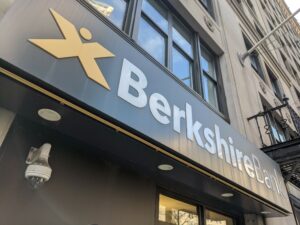Berkshire Bank had another quarter with positive earnings this spring, as executives remain optimistic that a new plan to transform the bank will lead to growth.
The Boston-based bank had second quarter net income of $21.6 million, or diluted earnings per share of $0.43, compared to the second quarter of 2020, when a $554 million goodwill impairment charge triggered by the rapidly developing COVID-19 pandemic led to a $549 million loss, or a loss per share of $10.93.
“We posted a solid quarter of improved earnings, with increased business activity and a stable margin,” Berkshire CEO Nitin Mhatre said in the bank’s earnings statement. “Efficiency improved and our return on tangible common equity advanced to 7.9 percent. Credit performance improved across the board as our customers return to more normalized operations.”
Mhatre, who became Berkshire’s CEO in late January, had unveiled a growth strategy in May that the bank has branded as “BEST,” or “Berkshire’s Exiting Strategic Transformation.”
“Under this plan, we get better before we get bigger, as we target to earn in excess of our cost of capital on completion of the three-year plan,” Mhatre said in the earnings statement. “We’re taking advantage of multiple merger-related market disruptions to add customers and to supplement our strong team with additional talent. Our BEST plan includes capital optimization and returning capital to shareholders, and in the second quarter we announced a stock repurchase program and initiated share buybacks.”
More Branch Closings
Part of that plan also involves a further reduction of the bank’s branch footprint, with up to 10 percent of its New York, Vermont and Massachusetts branches closing later this year or in 2022.
This reduction is in addition to 16 branch closings the bank had announced late last year. So far 15 of those offices have closed, President and Chief Operating Officer Sean Gray said in an earnings call on Wednesday. He added that the bank has a history of retaining customers during consolidations, and that the deposit retention from the current consolidation exceeded expectations.
Mhatre added that the bank has also been able to retain employees during the consolidation.
“We have retained our customers, retained the deposits, but we’ve also done a remarkable job of retaining bankers through managing through attrition, which has been the strength of this organization,” Mhatre said.
In addition to closing branches, the $12.3 billion-asset Berkshire is also finalizing the deal to sell eight Mid-Atlantic branches to a New Jersey bank. Subhadeep Basu, Berkshire’s chief financial officer, said the deal was expected to close in the third quarter, but would not provide the expected date.
Lower operating expenses helped drive the bank’s second quarter performance. Noninterest expenses were down 2 percent compared to the second quarter of 2020, not including expenses related to the goodwill impairment. In addition to branch closings, the decrease was due in part to lower costs for professional services and compensation.
Noninterest income increased by $5 million, or 27 percent, compared to the same quarter last year. Berkshire said in its earnings statement that the bank had a $2 million increase in deposit-related fees and a $3 million increase in revenue from U.S. Small Business loan originations. Part of the bank’s strategy includes increasing its SBA lending, and the bank said the $5.3 million in SBA-related revenue in the second quarter reflected strong market conditions and the expansion of its SBA team.
Berkshire has already started to take advantage of the disruption caused by merger activity in the region. The bank has brought over a commercial real estate loan in the South End and a commercial and industrial loan in Worcester from competitors currently involved in mergers, according to its second quarter investor presentation.




 |
| 




